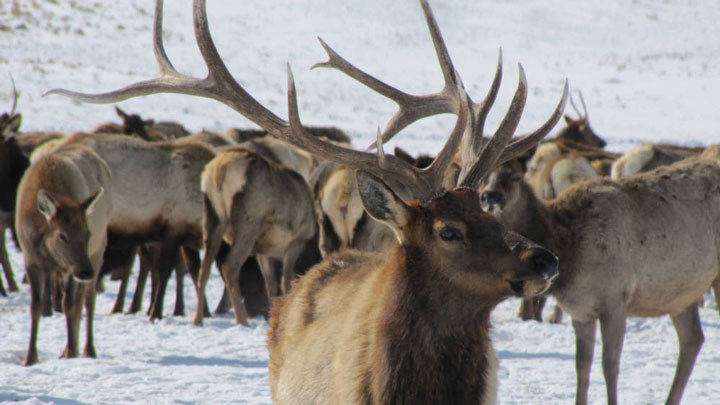
by Brian McCombie - Thursday, February 11, 2021

The 2020 elk hunting season was an awesome experience for Wisconsin resident and hunter Jed Becker. Not only did he draw one of the coveted five Wisconsin elk hunting tags, but Becker bagged an impressive 6x6 bull from the southern section of the Clam Lake Elk Range in the northern part of the state.
“I hunted eight days in a row,” said Becker, 32. “We had fresh snow and I was hiking over 10 miles a day some days. I got kind of down a few times on those days when I wasn’t seeing any elk, but I stuck with it and then it all came together. Amazing experience!”
An elk season in Wisconsin, you say? On The frozen tundra? Yes, indeed!
Native to Wisconsin and the Upper Midwest, elk were extirpated from Wisconsin in the 1880s. More than 25 years ago, the Wisconsin Department of Natural Resources (WDNR), the Rocky Mountain Elk Foundation and many Wisconsin volunteers began launching efforts to reintroduce elk into the Dairy State.
According to a WDNR news release, the original Wisconsin herd began with the release of 25 Michigan elk in 1995. Twenty years later, in 2014 and 2015, 26 Wisconsin elk were released in the expanded range using an assisted dispersal process. In addition, it noted, 92 Kentucky translocated elk were released in 2017 and 2019 on the Flambeau River State Forest. By 2020, the state’s Clam Lake Elk Range had an estimated population of about 300 elk.
The first modern Wisconsin elk hunt was held in 2018. The hunts have been limited to 10 tags, half of which are held by Native American tribes with the remaining five issued to Wisconsin residents. Wisconsin elk hunt applications cost $10, with $7 earmarked for statewide elk management, habitat and research.
For the 2020 season, as the WDNR news release explained, the agency selected four hunters at random from a pool of about 28,000 applicants. The RMEF awarded the fifth state-issued tag through an RMEF fundraising raffle, choosing a winner from nearly 1,600 tickets.
The RMEF and RMEF Wisconsin, the organization’s 11,000 members in the Dairy State, have been huge supporters of the elk reintroduction and hunts, with elk-tag raffle proceeds specifically set aside for elk management. This year, as it has done every year since 2018, RMEF Wisconsin will again raffle one of the elk tags.
“The annual elk tag that RMEF raffles has generated approximately $85,000 for Wisconsin Elk Management so far,” said Kurt Flack, RMEF’s Regional Wisconsin Director.
In Wisconsin, RMEF and its partners have completed 519 conservation and hunting heritage outreach projects with a combined value of more than $9.4 million. These projects have protected or enhanced 7,093 acres of habitat and have opened or improved public access to 1,170 acres.
RMEF members also volunteer for the WDNR’s elk program, including to help with elk calf searching and collaring and assisting with various habitat projects. Wisconsin hunters and non-hunters alike have volunteered their time to help with elk restoration, noted Joshua Spiegel, WDNR Wildlife Biologist for Sawyer County.
“The most common use of volunteers is to monitor Snapshot Wisconsin remote game cameras that are deployed 365 days a year in designated locations collection data, not only for Wisconsin elk, but all animals in the area,” Spiegel explained. “This important information is part of our population estimate process and used for herd dynamic figures. These cameras are monitored and uploaded by volunteers.”
But the elk are a huge draw not only for hunters and conservationists but people in general. In fact, the elk have become a regular tourist draw.
“Wisconsin elk tourism seems to be pretty diverse,” said Spiegel. “We draw interest from hunters, nature groups, bird watchers, educational groups and general sightseers. Elk have provided an opportunity that is rare for folks in the Midwest, and they really bring many people with many different backgrounds together.”
Conservation, hunting, tourism and people working together: All these factors have combined to make the Wisconsin elk reintroduction a resounding success.
E-mail your comments/questions about this site to:
[email protected]
Proudly supported by The NRA Foundation and Friends of NRA fundraising.
